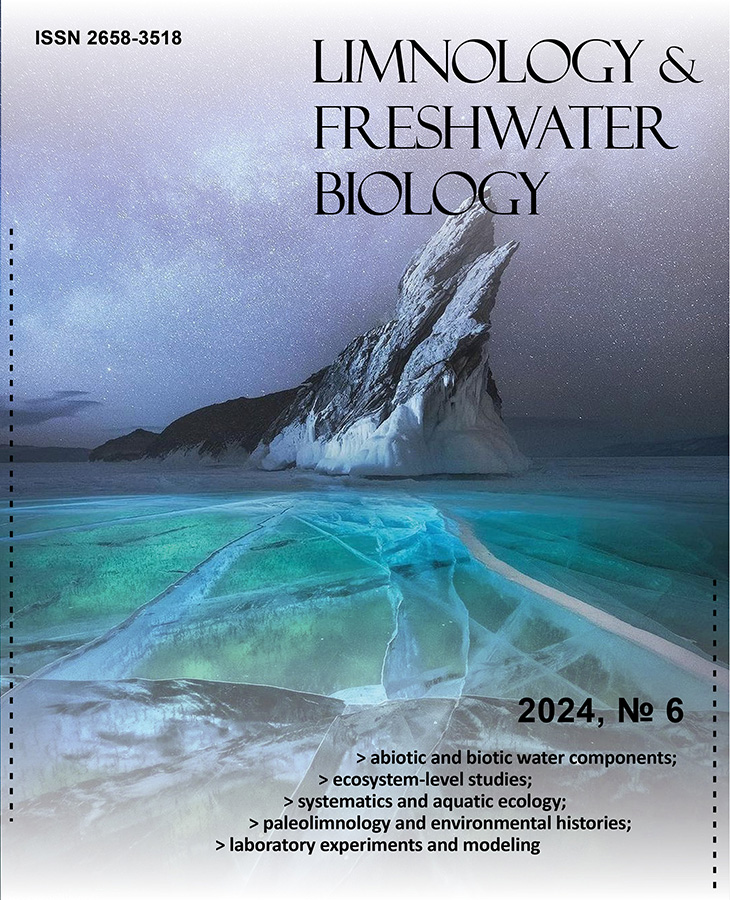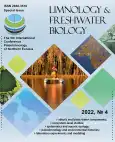Reconstruction of evolution of a shore lake (the White sea, NW, Russia) based on spore-pollen analysis
- Авторы: Lazareva O.V.1
-
Учреждения:
- Institute of Geology of the Karelian Research Centre of the Russian Academy of Sciences
- Выпуск: № 4 (2022)
- Страницы: 1462-1463
- Раздел: Статьи
- URL: https://journal-vniispk.ru/2658-3518/article/view/289404
- DOI: https://doi.org/10.31951/2658-3518-2022-A-4-1462
- ID: 289404
Цитировать
Полный текст
Аннотация
The paleo-geographic conditions of sedimentation in a small nameless lake on the Karelian White Sea shore were reconstructed. The data obtained were used to trace the vegetation dynamics from the Boreal time. The time of transition from the marine to freshwater regime was determined.
Ключевые слова
Полный текст
1. Introduction
Bottom sediments from a small nameless lake (28.7 m a.s.l, N 66° 15ʹ 34.4ʹʹ, E 33° 39ʹ 22.2ʹʹ) on the Karelian White Sea shore near the Keret Town were studied. Changes in the position of the White Sea shoreline were assessed the isolated basins method (Hafsten, 1960; Donner et al., 1977). The method is based on the study of bottom sediments from continental freshwater bodies, where sedimentation conditions varied from marine to freshwater (transition zone). Spore-and-pollen analysis was performed with regard for halophyte pollen identified as an indicator of marine conditions. Such indicators were identified earlier by Lavrova et al. (2010), Shelekhova and Lavrova (2011) and are now studied by author.
2. Materials and methods
Sediments in small water bodies, located at different hypsometric levels were drilled. The results of spore-and-pollen analysis of one of the lakes are discussed in the paper. Samples for spore-and-pollen analysis were prepared using a standard procedure (Pylʹtsevoy analiz, 1950). Pollen was identified using manuals (Kupriyanova and Aleshina, 1972; 1978) and personal standard maps of figures and descriptions, as well as the pollen database http://botany-collection.bio.msu.ru.
3. Results and discussion
A spore-and-pollen diagram of bottom sediments, based on analytical results, was constructed. Seven pollen zones (PZ), consistent with modified Blytt-Sernander’s scheme were identified (Khotinsky, 1977). At a depth of 1110-931 cm, the samples contain no pollen grains. Woody tree pollen were dominates throughout the entire sequence (99%).
PZ1 Pinus-Betula sect.Albae- Plantago sp.-Polypodiaceae-Hepaticae (depth 931-870 cm). The palynozone is characterized maximum woody tree pollen values yielded mainly by Pinus (up to 90%) and Betula sect.Albae (up to 15%). The rare pollen grains of the obligate halophyte Plantago maritima were identified. The sporophyte dominate groups were presented by Polypodiaceae and Lycopodiaceae. Hepaticae spores, commonly occurring on non-formed soils, are scarce.
The obtained data show that the study area was covered by thinned pine forests, as indicated an abundance of Lycopodiaceae. The presence of pre-Quaternary sporomorphs suggests the rewashing of sediments at the marine stage of the lake. The sediments was most probably formed in the early Boreal Period.
PZ2 Pinus-Ulmus-Alnus incana-Atriplex nudicaulis-type Aster (depth 870-748 cm) differs from the previous palinozone as the presence of Ulmus and the persistence of maximum Pinus (up to 90%). Alnus incana increases to 1%. The pollen grains of the halophyte Atriplex nudicaulis, type Aster (presumably Tripolium vulgare) are scarce. Sporophytes abruptly become less abundant. The spectra of PZ2 likely formed in the Boreal time. The vegetation consisted of north-taiga forests (with a minor contribution of birch), which became more closed. Typical halophytes were present in the coastal zone.
PZ3 Betula sect.Albae-Ulmus-Quercus robur-Tilia cordata-Chenopodiaceae (depth748-705 cm). The palinozone displays a decrease in Pinus pollen (to 60%) and an increase in Betula sect. Albae pollen (up to 30%). Quercus robur and Tilia cordata pollen grains emerge in the spectrum. The sediments of PZ3 likely correspond to the early Atlantic Period.
PZ4 Picea-Pinus-Ulmus-Corylus-Atriplex nudicaulis-Plantago sp.-type Aster (depth 705-672 cm) differs from the previous one in sharply increased in Picea (up to 20%) and Pinus (up to 80%), as well as Ulmus and Corylus peaks. The presence of the pollen of the obligate halophytes Atriplex nudicaulis and Plantago sp., type Aster (presumably Tripolium vulgare) indicates the formation of marine sediments. Sediments in the palinozone formed in the mid-Atlantic Period.
PZ5 Picea (depth 672-630 cm) the percentage of Picea increased (up to 30%), while that of Pinus pollen decreases to 50%. Coniferous plant stomata were encountered in the spectra for the first time. Typha latifolia and Utricullaria pollen of the aquatic group was observed. The spore-and-pollen spectra of this time interval display the pollen grains of halophytes and representatives of coastal-aquatic freshwater vegetation. The zone marking a transition from marine to freshwater conditions was thus identified. The eggs of tardigrades, who prefer freshwater environments, are present. Sediments in this palinozone formed at the final stage of the Atlantic. This evidence is supported by two radiocarbon age dates (depth 666-661cm was 5610+-200 14C yr., and 661-656 cm was5270+-11014C yr.,). Mid-taiga spruce forests mixed with birch were spread on the area.
PZ6 Pinus- Picea-Ericales (depth 630-590 cm) was identified by an abruptly increased abundance of Pinus pollen (up to 85%) and a decrease in Picea pollen (to10%). Ericales pollen in the spectrum increases.
PZ7 Pinus-Pediastrum (depth 590-550 cm), the woody plant group Pinus was dominate (up to 90%), while the percentage of Betula sect.Albae decreased to 5%. Colonies of the alga Pediastrum emerged in the spectra and is indicative of freshwater conditions. Sediments in palinozones PZ6-PZ7 formed in the Late Holocene. The spruce-pine forests cover was dominated.
4. Conclusions
A long time during the Boreal - Late Atlantic Periods (depth 931- 660 cm) the study area was covered by the sea. Since the Mid-Atlantic Period, the sea boundary began retreat and the sea gradually began to desalinate (depth 660-630 cm). In the Late Atlantic Period, the reservoir separated completely and began to evolve as an independent freshwater body. The plant cover in the Boreal consisted of north-taiga birch-pine forests mixed with birch. The intensive paludification of the study area began at the final stages of the Holocene.
Acknowledgements
The studies were carried out under the State Assignment for the Institute of Geology, Karelian Research Centre of RAS (№АААА-А18-118020690231-1).
Conflict of interest
The author declares that she has no known competing financial interests or personal relationships that could have appeared to influence the work reported in this paper.
Об авторах
O. Lazareva
Institute of Geology of the Karelian Research Centre of the Russian Academy of Sciences
Автор, ответственный за переписку.
Email: ox-laz@yandex.ru
Россия, Pushkinskaya str., 11, Petrozavodsk, 185910
Список литературы
- Kupriyanova L.А., Aleshina L.А. 1978. Pylʹtsa dvudolʹnykh rasteniy flory Yevropeyskoy chasti SSSR [Pollen and spores of bilobate plants in European USSR’s flora. V.1]. Leningrad: Nauka. (in Russian)
- Kupriyanova L.А., Aleshina L.А. 1972. Pylʹtsa i spory rasteniy flory Yevropeyskoy chasti SSSR. Tom 1 [Pollen and spores of plants in European USSR’s flora. V.1]. Leningrad: Nauka. (in Russian)
- Lavrova N.B., Kolka V.V., Korsakova О.P. 2010. Pollen as an indicator of White Sea shoreline migration. In: LVI session of the Paleontological Society RAS “Evolution of the organic world and biotic crises”, pp. 64-66. (in Russian)
- Pylʹtsevoy analiz [Pollen analysis]. 1950. In: Pokrovskaya I.М. (Ed.). Мoscow: Gosgeolizdat. (in Russian)
- Khotinsky N.А. 1977. Holocene Severnoy Yevrazii. Opyt transkontinentalʹnoy korrelyatsii etapov razvitiya rastitelʹnosti i klimata [Holocene of Northern Eurasia. Experience of Transcontinental Correlation of Stages of Vegetation and Climate Development]. Мoscow: Nauka. (in Russian)
- Shelekhova Т.S., Lavrova N.B. 2011. New data on White Sea shoreline migration. Uchenyye zapiski Petrozavodskogo Gosudarstvennogo Universiteta [Scientific Notes of Petrozavodsk State University] 2(115): 24-32. (in Russian)
- Hafsten U. 1960. Pollen-analytical investigations in South Norway. In: Holtedahl O. (Ed.), Geology of Norway. Norges Geologiske Undersøkelse. Vol. 208, pp. 434-462.
- Donner J., Eronen M., Jungner H. 1977. The dating of the Holocene relative sea level changes in Finnmark, North Norway. Norsk Geografisk Tidsskrift 31: 103-128.
Дополнительные файлы










